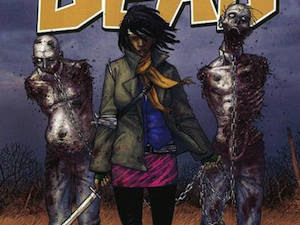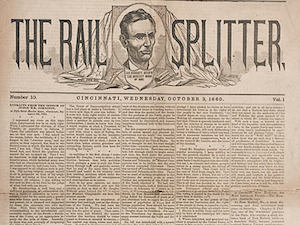
Longtime readers will remember that last year I pondered the connection between zombies and the slave trade. So it was pleasing to see the New York Times following a similar thread this week. As the author points out, though rooted in African tradition, zombies are a distinctly New World development, and the relationship between the undead and the enslaved is almost too obvious to mention. The evidence is ubiquitous, lurking just below the surface of our mass cultural consciousness. The wildly popular TV adaptation of The Walking Dead now stars Michonne, a ninja warrior who, among other things, sports her own zombie slave coffle. The two black men she pulls behind her are defanged and controlled by large metal collars and long metal chains that clank and clatter as they stumble along. Whether intentional or not, the echoes of racial slavery are conspicuous and searing – the show itself takes place in the Deep South. And the image of a powerful black woman dragging docile, neutered, and chained zombies across the southern landscape is stunningly poetic.
The living dead are more than just a metaphor for slavery and alienation. As I tried to suggest in my earlier post, they are an enduring artifact of the slave trade, a trade steeped in violence and death, whose legacies continue to haunt us to this day. Zombie folklore is complex and malleable. The ghostly return of the “Zombi” terrified New World slave societies as early as the eighteenth-century. As Francine Saillant and Ana Araujo show, the zombie myth can even serve as a form of empowerment. The seventeenth-century maroon warrior Zumbi is remembered in modern Brazil as a hero, a figure whose quest for autonomy transcends death itself. I’m still waiting for a long form treatment of this pressing and endlessly fascinating topic. In the meantime, the undead continue to beckon.
The 2012 blockbuster Abraham Lincoln: Vampire Hunter, based on the equally-popular mashup novel by Seth Grahame-Smith, does not attempt to present itself as serious history, which is probably a good thing. Like the forthcoming Tarantino flick Django Unchained, it eschews documentary realism in favor of highly stylized violence (Vampire Hunter director Timur Bekmambetov also directed the underrated minor masterpiece Night Watch). Still, there is something oddly compelling about the film’s portrayal of southern slaveholders as voracious vampires who literally drain the life force from their human property. As W. Scott Poole points out in his delightful review, there was “at least one case in Louisiana [in] which newly imported slaves became convinced that [their purported] masters were witches and vampires (after watching them drink red wine).” Although the real Lincoln was hardly a staunch egalitarian, the film offers up a more soothing alternate reality in which (SPOILER ALERT) Harriet Tubman rescues an axe-wielding Abe on the Underground Railroad and the two work together to save the entire Union cause. Despite her pivotal role in the story I would have liked to see more of Tubman, who was among the first American action heroes (just compare this sketch of her in battle fatigues to this image of Michonne). But I guess Harriet Tubman: Vampire Hunter would have been a little too transgressive.
There have been a spate of Lincoln-related movies lately, including The Conspirator, Saving Lincoln, and the forthcoming Spielberg epic Lincoln, which is based in part on Doris Kearns Goodwin’s Team of Rivals. It will be interesting to see how the emotionally earnest realism of the Spielberg film compares with Django, a spaghetti-western-inspired revenge story with shades of the Murrell Conspiracy. Grahame-Smith’s interpretation of the Civil War era offers something different insofar as it openly parodies Lincoln’s heroic mythology. At the same time, it could be read as reinforcing the image of the sainted leader. Whether slaying vampires or emancipating slaves, Honest Abe is always at the center of the action.
“The Great Man,” wrote historian Thomas Carlyle, “is a Force of Nature.” Carlyle probably hated Lincoln. The only thing he despised more than elective democracy was slave emancipation, and he was a Confederate partisan. Even so, the nature analogy may be apt. Abraham Lincoln is something like the black hole of nineteenth-century American history, an irresistible gravitational force pulling in anything and everything around it. Once you cross the event horizon of 1861, the beginning of the United States Civil War, it is nearly impossible to escape. Many of the giants in my field began their careers studying slaveholders or abolitionists and ended up writing Big Books on Lincoln and/or the Civil War. While these are certainly worthy topics, I have never found them particularly enthralling. The real war, I would argue, began in the 1770s and seethed for nearly a century, sometimes expressing itself culturally, sometimes politically, sometimes breaking out into open violence. The events of 1861-65 were important, but they were also the manifest symptom of a more extensive conflict, the final breaking out into the open of an ongoing, decades-long war over slavery.
The cult of Lincoln conceals the extent to which he was controlled by events running much deeper in the national and international political landscape and how his own deft strategizing intersected with those events to shape the outcome of the struggle. Although politicians and generals played a crucial role in the Civil War, there is plenty of evidence to suggest that grassroots developments were just as significant in determining the logic and pace of the radical changes sweeping the country. Data from the Visualizing Emancipation project, for example, clearly show that emancipation events – especially events classified as “African Americans Helping the Union” and “Fugitive Slaves/Runaways” – drastically increased in the ten months prior to the signing of the Emancipation Proclamation. The proclamation cemented this momentum and allowed it to expand. Lincoln’s fictional alliance with Tubman in Vampire Hunter hints at this dynamic. Ultimately, however, the depiction of the sixteenth president as a flawless force of nature, almost single-handedly responsible for the Union victory, obscures a lot more than it reveals.

The larger-than-life image of Lincoln as a world-historical figure, as the “Great Emancipator,”as the free laboring “Rail Splitter,” which provides the grist for Grahame-Smith’s revision, did not just appear out of thin air following his martyrdom. It was actively disseminated during his lifetime by editors, politicians, and paramilitary organizations such as the Wide Awakes. The latter group, which numbered in the hundreds of thousands, saturated the northern and border states with Lincoln’s image and served as shock troops for the Union cause. In other words, Lincoln had a pretty efficient public relations machine. And this brings me to the digital humanities (how’s that for an overwrought segue?)
In a classic post on the Social Contract of Scholarly Publishing, Dan Cohen argues, among other things, that academic authors need to do a better job cultivating an audience for their work. This can be done in the digital realm, he suggests, by pioneering new curatorial frameworks, by developing new ways to disseminate, promote, and review scholarship online. Common-Place, Digital Humanities Now, and the American Historical Review prize for Best Digital Article represent promising steps in this direction. The last of these seems especially significant, since it will only accept work that is “impossible in print.” But offering up innovative work in a trusted and easily accessible format, carving out new spaces for the play of ideas, is only half the battle. As any Hollywood producer will tell you, films like Abraham Lincoln: Vampire Hunter, Lincoln, and Django Unchained are only as successful as their attempts to present a recognizable brand, stimulate public interest, and build an audience. Hollywood marketing is notoriously bloated and avaricious – sometimes far exceeding the size of a film’s actual budget. So I do not think academics would benefit from this model. But I wonder what would happen if professional historians had that kind of publicity? It might make the inevitable sequel, in which Frederick Douglass teams up with Frankenstein’s Monster to fight the Wolf Man, somewhat more palatable.